Cambodian cuisine
Cambodian cuisine (Khmer: សិល្បៈខាងធ្វើម្ហូបខ្មែរ) is the cuisine of the people of Cambodia, whereas Khmer cuisine refers exclusively to the cuisine of the ethnic Khmer people.[1]
.jpg.webp)
.jpg.webp)
| Part of a series on the |
| Culture of Cambodia |
|---|
 |
| History |
| People |
| Languages |
| Cuisine |
| Religion |
| Literature |
| Sport |
|
History and influences
Water, rice and freshwater fish exert the most profound influences on Khmer cuisine. The Mekong river, the twelfth longest in the world, cuts through the middle of Cambodia. The capital Phnom Penh is on its riverbank, at the junction where two other rivers meet: the Tonle Sap and Bassac. The Tonle Sap river connects the Mekong with the Tonle Sap lake, or Great Lake, which acts as a liquid heart and natural reservoir for the entire Mekong river system, regulating the flow of huge volumes of water, and allowing the safe passage of an astonishing number of freshwater fish. The lake itself is believed to have more fish than any other in the world and ranks second to the Amazon river in biodiversity.
.jpg.webp)
When the rainy season begins at the start of the Khmer New Year, the region becomes inundated with monsoonal rain and Cambodia turns into a vast ocean of emerald rice paddies. Rice is the staple food of Cambodia, and it is part of every meal, both as an accompaniment and used as an ingredient for many dishes. According to the International Rice Research Institute, there are 2,000 rice varieties indigenous to Cambodia that were developed over centuries by Cambodian rice farmers.[2] The geographical setting of wetlands (Cambodia ranks second to Bangladesh for the largest amount of wetland in Asia) and floodplains explains why water, and hence fish and rice (which grow in water) are such an integral component to the cuisine. Many dishes, in particular, the samlors, have a pond-like appearance, and are often loaded with reed-like plants, leaves, and vegetables, mirroring the surrounding landscape. Dipping sauces tend to be quite watery, as are most Cambodian curries.
Khmer cuisine shares many commonalities with the food of neighbouring Thailand—although, less chilli, sugar and coconut cream are used for flavour—and of neighboring Vietnam, with which it shares and adopts many common dishes, as well as colonial history, as both formed part of the French colonial empire in Southeast Asia. It has drawn upon influences from the cuisines of China and France, powerful players in Cambodian history. The Chinese began arriving in the 13th century, but Chinese migration accelerated during the French period. Curry dishes, known as Kari (in Khmer, ការី) show a trace of cultural influence from India. The many variations of rice noodles show the influences from Chinese cuisine. The Portuguese and Spanish also had considerable influence in Cambodian affairs in the 16th century, introducing chilli and peanuts into Asia from the New World. However, chilli never gained the same status or prominence as it did with the cuisines of neighboring Thailand, Laos, and Malaysia. Even today very few recipes include chilli.

One legacy of French cuisine, the baguette—known as nom pang in Khmer—is ubiquitous in all parts of Cambodia today. Cambodians often eat bread with pâté, tinned sardines or eggs. One of these with a cup of strong coffee, sweetened with condensed milk, is an example of a common Cambodian breakfast. Freshly buttered baguettes can be made into sandwiches (also called nom pang) and may be stuffed with slices of ham or any number of grilled meats, with Kampot pepper, similar to Vietnamese banh mi. The French also introduced beer, butter, pate, coffee, chocolate, onions, carrots, broccoli, potatoes and many other types of non-native produce Southeast Asia.
Traditionally, Cambodians eat their meals with at least three or four dishes. A meal will usually include a soup, or samlor, served alongside the main courses. Each individual dish will be either sweet, sour, salty or bitter in taste. Chilli (fresh, pickled or dried) and chilli sauce is served on the side and left up to individual diners and to their taste. In this way, Cambodians ensure that they get a bit of every flavor to satisfy their palates.
Ingredients
Fermented sauces

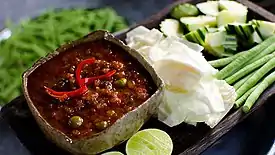
In Khmer cuisine, a distinction is made between fermented paste-based ingredients and pickled ingredients. Mam refers to fish or shrimp that has been fermented in a particular technique and is usually includes more solid pieces of the pickled animal. Mam is the general term for most kinds of fermented ingredients created from aquatic animals. Prahok and kapi are popular bases for sauces with pickled aged ingredients. Both mam and prahok are aged for a minimum of one year in order to reach the full taste potential, much like fish sauce. Fermented sauces are often eaten with high protein-based dishes or raw vegetables to aid digestion.
| Name | Description |
|---|---|
| mam (fermented seafood) | Mam refers to the salted, fermented fillets of snakehead fish, to which roasted red sticky rice and palm sugar are added during the fermenting process to impart an earthier and sweeter flavour. The sugar and rice also lends the ingredient a reddish tinge. From the time that the fish is filleted, mam can take over a year to reach maturity. Mam originates from the Mekong Delta in Vietnam. |
| prahok | A common ingredient, almost a national institution, is a pungent type of fermented fish paste used in many dishes, a distinctive flavoring known as prahok (ប្រហុក). It is an acquired taste for most Westerners and is an integral part of Khmer cuisine. It is included in many dishes or used as a dipping sauce. The liberal use of prahok, which adds a salty tang to many dishes, is a characteristic which distinguishes Khmer cuisine from that of its neighbours. Prahok can be prepared many ways and eaten as a dish on its own right. Prahok jien (ប្រហុកចៀន) is fried and usually mixed with meat (usually beef or pork) and chili. It can be eaten with dips, vegetables like cucumbers or eggplants, and rice. Prahok gop or prahok ang (ប្រហុកកប់) or (ប្រហុកអាំង) is covered with banana leaves and left to cook under a fire under pieces of rock or over the coals. When prahok is not used, kapǐ (កាពិ), a kind of fermented shrimp paste, is used instead. Khmer cuisine also uses fish sauce widely in soups and stir-fried dishes, and as a dipping sauce. |
| kapi | Another common ingredient in Khmer cuisine, this fermented shrimp paste is often mixed with garlic and chili peppers and used as a dipping sauce for grilled and fried meats. It is also a common ingredient in certain curries and papaya salads to add salt and richer flavors. |
| mam trey tok (fermented snakehead fish) | A variation of "mam" using a very popular fish, that lives in the flowing rivers of the Great Mekong. Its abundance makes it popular within Cambodia and Vietnam, where they are caught and used. It can be eaten by itself after it finishes fermenting. |
| mam bongkia (fermented shrimp) | A variation of mam, that contains small pieces of fermented shrimp. It is often used as an ingredient for cold noodle salads or condiments for family meals. |
| teuk trey (fish sauce)(ទឹកត្រី) | Fish sauce is an important ingredient in Khmer cooking, that is used to add salt in soups, noodles, or marinating meats. It is also used as a dipping sauce ("tuek chr'louk") containing many varieties depending on the type of dish presented in the meal. Fish sauce acts to counterbalance the flavors of the other dishes within the family meal to ensure that all five tastes are achieved to create a harmonious meal. |
| teuk krom (oyster sauce) | Oyster sauce was introduced by Chinese immigrants. It is a common ingredient in Khmer cooking that adds a tangy-sweet flavor to meats and stir-fried vegetables. Oyster sauce, along with the fish sauce, and soy sauce, as commonly used together when seasoning foods. |
| teuk si-iw (soy sauce) | A common ingredient and condiment, that is mixed with garlic or aged radish to be eaten with primarily high protein dishes. It is used to add salty flavors when the fish sauce is not used. |
| teuk siang (hoisin sauce) | Hoisin sauce is translated as "soybean sauce" in the Khmer language. It is used when marinating meat that will be grilled and especially for noodle soups such as "kuy teav" or "mee" (yellow wheat noodles). |
| teuk ampil (tamarind sauce) | A sauce using tamarind as a base, often mixed with garlic, palm sugar, and chili peppers. |
Spices
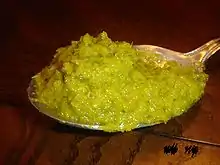
Black pepper is the preferred choice when heat is wanted in a dish; it is used in stir-fries, soups, marinades for grilled meats, and dipping sauces. Pepper has a long history in Cambodia, having been grown since at least the 13th century, while the pungent, aromatic variety from Kampot province (bordering Vietnam's Ha Tien province and the Gulf of Thailand to the south, and the jungle-clad Elephant Mountains to the north) was once Cambodia's chief export from the late 1800s up till the 1960s.
Kampot pepper was once known as the King of Peppers, revered by gourmets worldwide, especially known to Parisian chefs, for its floral and eucalyptus notes, its heady aroma, its musky heat, and its medicinal properties.[3] Before the 1970s, Kampot pepper was used in all French restaurants for the classic dish steak au poivre. Today, the pepper industry is being revitalised and, since acquiring protected Geographic Indication status in 2008 (which gives it the same special status as Champagne in France), people can purchase Kampot pepper online in many parts of the world.
Jungle cardamom, or wild cardamom, grows in the aptly named Cardamom Mountains in the southwest of the country, bordering the Gulf of Thailand coast to the south and Trat province in Thailand to the west. These vast mountains form some of the last remaining areas of intact virgin rainforest in Southeast Asia and harbour extensive mangrove forests, elephants, tigers, Siamese crocodiles and other rare and endangered species, and few people live in this area. Locals use cardamom medicinally and in certain samlors, using the root of the plant as well as the pod. Turmeric (Khmer: រមៀត) is grown in Battambang province and is a common ingredient in many curry powders, soups and rice dishes. Saffron is also esteemed in local folk medicine as a treatment for many ailments, especially skin problems.
Tamarind is commonly employed as a soup base for dishes such as samlar machu. Star anise is a must when caramelizing meat in palm sugar like pork in the dish known as pak lov. Turmeric, galangal, ginger, lemongrass and kaffir lime leaves are essential spices in Khmer cooking, Khmer stews, and nearly all curries.[4]
Skor Thnaot ('Palm Sugar') is one of the main ingredients in Khmer dessert as well as some caramelizing dishes and Samlor (Khmer soup). It is made from the sap of the palm sugar tree. It is known for its rich aroma and a nice brown color, which could make a nice ingredient of the dish. In 2016, Skor Thnaot Kompong Speu ('Kompong Speu Palm Sugar') was recognized as a geographical indication in Cambodia and it then was recognized in European Union in 2019.[5]
|
|
|
Kroeung
The result of freshly pounded spices, kroeung (គ្រឿង) is an important aromatic paste commonly used in Cambodian cooking.[6] Unlike Indian spice pastes, it almost always uses fresh ingredients, principally lemongrass, galangal, garlic, shallots and turmeric. To this basic mix may contain fingerroot, lime zest or leaf, or rehydrated red pepper for "individual kroeung" used for specific dishes.
Vegetables
Many vegetables used in Khmer cuisine are also used in Chinese cuisine. Vegetables such as winter melon, bitter melon, luffa, water spinach and yardlong beans can be found in soups and stews. Oriental squash can be stewed, stir fried or sweetened and steamed with coconut milk as a dessert. Vegetables like mushrooms, cabbage, baby corn, bamboo shoots, fresh ginger, kai-lan ("Chinese kale"), snow peas, and bok choy are commonly used in many stir fry dishes. Together these stir fry dishes are known by the generic term chhar (ឆា). Banana blossoms are sliced and added to some noodle dishes like nom banh chok.
|
|
|
Fruits
Fruits in Cambodia are so popular that they have their own royal court. The durian is considered the "king", the mangosteen the "queen", sapodilla the "prince" and the milk fruit (phlae teuk doh ko) the "princess". Other popular fruits include the jan fruit, kuy fruit, romduol, pineapple, star apple, rose apple, coconut, palmyra fruit, jackfruit, papaya, watermelon, banana, mango and rambutan. Although fruits are usually considered desserts, some such as ripe mangoes, watermelon, and pineapples are eaten commonly with heavily salted fish with plain rice. Fruits are also made into beverages called tuk krolok (ទឹកក្រឡុក), mostly shakes. Popular fruits for shakes are durian, mangoes, bananas.
|
|
|
Since 2018, Krouch Thlong Koh Trung (Koh Trung Pomelo), a special citrus fruit (similar to a large grapefruit), is recognized as one of the geographical indications in Cambodia.[7] That special Pomelo, grown in Koh Trung commune, is known because it is sweet rather than sour as normal citrus fruits do, and it contains no seeds once ripe.
Fish and meat

As the country has an extensive network of waterways, freshwater fish plays a large part in the diet of most Cambodians, making its way into many recipes. Daily fresh catches come from the Mekong River, Bassac River and the vast Tonlé Sap. Fish is far more common than meat in Khmer cuisine. Prahok itself is based on fish. Many of the fish eaten in Cambodia are freshwater fish from the Tonlé Sap or from the Mekong. Dried salted fish known as trei ngeat (ត្រីងៀត) are a favourite with plain rice porridge. The popular Khmer dish called Amok trey uses a kind of catfish steamed in a savoury coconut-based curry. The small fish are known as Trey Dang Dau are very common and are often eaten deep-fried.
While freshwater fish is the most commonly used meat in the Cambodian diet, pork and chicken are also popular. Though not as common as in neighbouring Vietnam, vegetarian food is a part of Khmer cuisine and often favoured by more observant Buddhists.
Pork is quite popular in making sweet sausages known as Sach Krok.
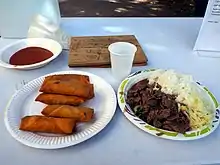
Beef and chicken are stewed, grilled or stir-fried. Seafood includes an array of shellfish such as crabs, clams, cockles, crayfish, shrimp and squid. Giant freshwater prawns, sometimes referred to as river lobsters, are not commonly eaten because of their price, but middle-class and rich Cambodians enjoy eating them. Duck roasted in Chinese char siu style is popular during festivals. More unusual varieties of meat include frog, turtle, and arthropods (including tarantulas) as well as insects such as crickets; these are difficult to find in Khmer cuisine abroad but are used in everyday dishes in Cambodia.
|
|
|
Noodles
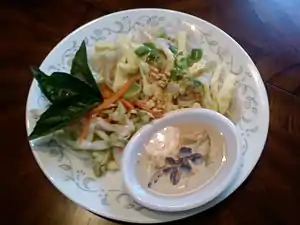
Many elements of Cambodian noodle dishes were inspired by Chinese cuisine[8] despite maintaining a distinct Khmer variation. Prahok is never used with noodle dishes. Rice stick noodles are used in mee katang (មីកាតាំង), which is a Cambodian variation of chǎo fěn with gravy. Unlike the Chinese styled chǎo fěn, the noodles are plated under the stir fry beef and vegetables and topped off with scrambled eggs. Burmese style noodles (មីកុឡា, Mee Kola) is a vegetarian dish made from thin rice stick noodles, steamed and cooked with soy sauce and garlic chives . This is served with pickled vegetables Jroak (ជ្រក់), julienned eggs, and sweet garlic fish sauce (which is actually not vegetarian) garnished with crushed peanuts. Mi Cha (មីឆា) is stir-fried egg noodles.
|
|
|
Popular dishes
Cambodian street foods (m'houp tam plouv) are a combination of influences from China and Southeast Asia. There exist a variety that are often not known to people outside of Cambodia. Street food is considered a snack rather than a meal. Food stalls are called hang or tiam, a Khmer word borrowed from Chinese háng ("store", "business") or hang bai (bai means "rice" or "food") and in order to identify the specific food for sale, food eateries are addressed as Hang/Tiam Kuy Teav (Rice Noodle Stall) or Hang/Tiam Kafe (Coffee Stall), for example.
Noodle soups
.jpg.webp)
Cambodian cuisine features a variety of noodles in which different types of noodles are used in different broths, such as kuy teav broth eaten with mee sua noodle or lort. Khmer noodles have origins from Chinese influences and bear many similarities to other noodles in Southeast Asia.
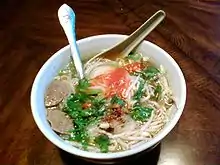
| Name | Description |
|---|---|
| Kuy teav (meaning flat rice noodle) (គុយទាវ) | In the Khmer language, kuy teav refers to the dish and the rice noodles themselves. This traditional pork broth-based rice noodle soup dish is a popular breakfast dish in Cambodia and is popular in neighbouring countries and in countries that have a large Khmer population. Originally developed by Cambodians of Chinese descent, it is always served with the garnishes of lettuce leaves, bean sprouts, chopped scallions, black Kampot pepper, lime juice, and fried garlic. Kuyteav may be served in one of two ways, with all the ingredients in the soup, or with the soup on the side. Both versions have the same ingredients and allow the diner to control the balance of flavours, temperatures and textures. The Phnom Penh version of kuy teav (called hu tieu Nam Vang by the Vietnamese) is the most extravagant, often containing some or all of the following toppings: pork belly, ground pork, congealed pig blood, chopped pork offal such as intestine, heart, liver and lung, roasted duck, Mekong river prawns, fish cake and squid. Modern versions of kuyteav featuring beef(rather than the original pork-based broth) have evolved recently, but the plethora of garnishes that distinguish kuyteav remain the same. It is similar to the Thai kuaitiao ruea and Thai kuaitiao sukhothai. |
| Kuy teav Ko Kho (caramelized rice noodles) | A rice noodle dish created from the stewed/braised flavors of beef combined with flat rice noodle. It features French influences including potatoes and carrots topped off with chives and cilantro. It is eaten with bread as well. A similar dish exists in Vietnam called hủ tiếu bò kho. |
| Mee Kiev (dumpling noodle) | Mee meaning egg noodle and Kiev meaning dumpling, from Hokkien "Kiau", is a Khmer rendition of wonton soup. The broth is clear topped with Chinese chives and the dumplings are filled with seasoned minced pork and shrimp. Variations often served with yellow wheat noodle and a mixture of rice-wheat and rice noodle (Kuy teav Mee Kiev). |
| Num banh chok (meaning rice noodle) | A well-known and beloved Cambodian dish found at streetside vendors, restaurants, produce markets (psahs) such as the Psah Thom Thmey (Central Market, Phnom Penh) and in shophouses. In English it's often simply called simply Khmer noodles, owing to its ubiquity across the country. Nom ban chok is a typical breakfast food and was originally a regional speciality from Kampot province, consisting of noodles laboriously pounded out of rice, topped with a fish-based green curry gravy made from lemongrass, turmeric root and kaffir lime. Fresh mint leaves, bean sprouts, green beans, banana flower, cucumbers and other greens are heaped on top by the diner. There is also a red curry version that is usually reserved for ceremonial occasions and wedding festivities (see Samlor kari). Similar dishes exist in Thailand, Laos, and Myanmar. |
| Num Banh Chok Somlar Kari | A rice noodle dish eaten with a Khmer curry soup. The curry may be yellow (Turmeric soup base) or red (Chili curry soup base) depending on the type of soup created and generally include chicken (including legs) or beef, potatoes, onions, and carrots. |
| Num Banh Chok Namya | A rice noodle dish featuring a Thai sour soup based (Thai Namya) that are popular during festivals and family gatherings. It features the same vegetables and herbs in Num Banh Chok Teuk Prahok although the Name is created with Thai green curry paste. |
| Num Banh Chok Kampot | A speciality of Kampot featuring a cold rice noodle salad rather than a soup base of Num Banh Chok. It features cuts of spring rolls, a variety of herbs, grounded nuts, pork ham, and fish sauce. |
| Num Banh Chok Teuk Mahech | A soup speciality of Kampot that features a clear fish broth (that does not feature the use of prahok) cooked with chives and vegetables. It is a regional speciality not found in Phnom Penh and other parts of Cambodia where Khmer and Vietnamese varieties of Num Banh Chok are eaten. |
| Num Banh Chok Samlor Yuon | A rice noodle soup that has origins from the Kinh (Vietnamese) populations in the urban areas of Cambodia. It is most similar to Vietnamese Bún Riêu featuring a red blood pork soup base and balls of minced crab meat. It also features more variety of herbs and vegetables not used in Vietnam. |
| Banh Sung | A slimy rice noodle dish that is a common lunch snack within the markets in Southern Cambodia. It features coconut milk, fish sauce, pork ham, and assorted mint and vegetables. It is similar to the Vietnamese dish bánh tằm bì. |
Samlor (soup/stew) and chhnang plerng (hotpot)
Samlor refers to soup dishes that are eaten with rice and Sup refer to dishes that can be eaten without the need of rice, these usually being dishes of Chinese or European origin. Chhang Plerng refers to the general term of Hotpot that is popularly eaten during the dry "cold" season (winter) and during late-night gatherings.
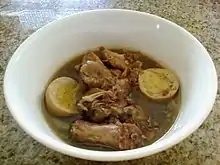

| Name | Description |
|---|---|
| samlar machu (សម្លម្ជូរ) | Actually denotes an entire class of samlor, whereby the dominant flavour is an aromatic, citrusy tartness, and there are many different versions. Of all the primary flavours (salty, sweet, spicy, sour, bitter, umami), Khmers are most fond of sourness, almost every town or province has its own unique version of samlor machu including samlor machu kroeung (featuring kroeung paste, turmeric, water morning glory, coriander, stewed beef ribs and tripe), samlor machu Khmer Krom (featuring tomato, pineapple, catfish, lotus root and holy basil) and samlor machu Siem Reap (containing bamboo shoot and tiny freshwater shrimp). The sourness and citrus flavour can come from prahok, tamarind, lemongrass, kaffir lime, lime juice, or herbs like lemon basil.[9][10] It is cognate with the Vietnamese sour soup canh chua. |
| samlar kakou (Khmer: សម្លកកូរ) | Traditional dish soup of Cambodia. It's also considered as one of Cambodian's national dish . The soup base is created from a variety of vegetables that reflect the environment of rural Cambodia as well as the use of prahok to create a tangy salty taste. |
| samlar prahaer (Khmer: សម្លប្រហើរ) | This is a fish stew flavored with prahok and a kroeung made from lemongrass, turmeric, fingerroot and garlic. The primary vegetables included in the stew are kabocha, taro and various mushrooms. Other local vegetables are added according to taste and availability. |
| babor (rice porridge) (បបរ) | Derived from the standard Chinese congee, this quintessential breakfast dish has many regional Cambodian incarnations. A type of porridge made with white rice, plain or with a chicken or pork broth, and served with fresh bean sprouts, caramelised garlic oil, green onions, omelette, fried breadsticks or dried fish (trey ngeat) from the Tonle Sap. Babor prai is the name for the common marketplace dish of salted dried fish with rice porridge. |
| kho (ខ ឬសម្លខ) | Braised pork or chicken and egg stew flavored in caramelized palm sugar, fish sauce and black Kampot pepper. It may contain tofu or bamboo shoots and often substitutes quail eggs for chicken eggs. A typical Khmer Krom dish , khor is similar to the Vietnamese dish of thịt kho and the Filipino dish called humba. |
| hong | A braised beef stew similar to kho with the exception that it doesn't feature eggs and the extensive use of dark soy sauce. The dish is also sweeter and saltier than Kho. This dish has origins from South Chinese migrants and is similar to hongshao rou. |
| chap chai | A Khmer soup of Chinese origins that is created with the use of cabbage, mushrooms, and quail eggs. The broth is clear and herbs are Cambodian addition in order to make the soup hearty. |
| ngam nguv | Is a chicken soup flavored with whole pickled lemons. |
| samlar kari (សម្លការី) | Is an Indian influenced Cambodian curry soup. It is a traditional wedding and celebration dish, features coconut chicken curry gently spiced with paprika, and with a soupy consistency, often cooked with sweet potatoes, and julienned onion. The soup is also used as a dipping sauce for fresh baguettes, while nom ban chok samlor kari is often served for breakfast the next day, featuring the same ingredients to make nom ban chok but using the samlor kari broth instead of the traditional turmeric and fish-based broth that goes into making nom ban chok.[11] The use of French baguette comes from Cambodia's colonial past. |
| chhnang plerng (fire pot) | Is the most common form of hot pot eaten in Cambodia in which a heated pot with a clear broth, meat, and assorted vegetables are eaten between family members. chhnang plerng is the general term for hotpot and there exist a variety of hotpot that undergo different names with mixed influences from China.
|
Chha (stir-fried dishes) and rice dishes
The term chha refers to stir-frying techniques introduced by Chinese immigrants (from Hokkien Tshá).
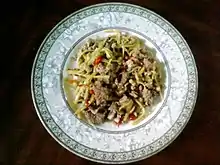
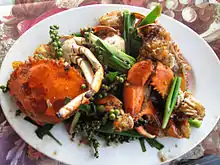
.jpg.webp)
| Name | Description |
|---|---|
| Chha Kuy Teav (meaning stir-fried flat rice noodle) | Is a Khmer version of a stir-fried flat noodle dish that is a speciality of Southern regions of Cambodia. It often features the use of dark and sweet soy sauce and a different assortment of meats. It is topped with sauté scallions, egg, pork ham, and cuts of spring rolls. |
| Chha Kh'nhei (ឆាខ្ញី) (meaning stir-fried ginger) | A spicy stir fry (chhar) of meat, usually chicken, eel or frog flavoured with julienned gingerroot, black Kampot pepper, garlic, soy and sometimes fresh jalapeños or fresh peppers, for extra heat. |
| Bai Chha (បាយឆា) | Is a Khmer variation of fried rice which includes Chinese sausages, garlic, soy sauce, and herbs, usually eaten with pork.. |
| Bai sach chrouk | Is a common breakfast street food featuring rice, char siu barbecue pork, egg (scrambled, steamed, fried, or caramelized), chive soup, Chrok (pickled vegetables) or preserved radish, and soy sauce or fish sauce condiments. |
| Bai Moan (AKA Bai Sach Moan; meaning Chicken Rice) | Is a Cambodian street food of Chinese origins from Hokkien and Hainanese immigrants from the 17th century. It is similar to Malaysian/Singaporean Hainanese chicken rice with the exception that lemongrass paste (kreoung) is mixed with the rice before being steamed. |
| Phak Lav | Is a dish of caramelized/braised organs, both a home dish and popular street food. A similar dish exists in Vietnam called Phá Lấu. |
| Mee Chha | A common street food where wheat yellow noodles are stirred fried with beef and vegetables and topped with an egg and gravy. |
| Trakuon Chha (stir-fried water spinach) | Is a common vegetable dish eaten at dinners. The water spinach (Ipomoea aquatica) is stir-fried in oil, garlic, red peppers, and minced pork, fermented soybeans, and soy sauce. |
| Lort Chha (meaning stir-fried "falling-out" noodle) | Are Cambodian thick short tapioca noodles, with added eggs and chicken, eaten mainly with fish sauce. Lort refers to any substances that fall through a hole, as such, these are how the tapioca noodles are made. Variations exist in Thailand, Laos, and Hong Kong. |
| Mee Kantang (មីកាតាំង) | Wide rice noodles in an oyster sauce typically stir-fried with eggs, baby corn, carrots, gai lan, mushrooms and a choice of meat, usually beef. The name of the dish translates literally as Cantonese-style noodles in Khmer, revealing its origin among the early Cantonese community in Cambodia , while also being similar to the Hong Kong-style beef chow fun with gravy. |
| Mee Sua Cha (meaning stir-fried sewed noodles) | Is a dish in which cellophane noodles are stir-fried with garlic, vegetables, mushrooms, and oyster, fish, and soy sauce. The dish is most commonly made during holidays such as Pchum Ben, or temple festivals to give to monks or to honour ancestors. |
| Mee Kola (meaning Kola noodle) | Is a noodle dish created by the Kola ethnic minority in western provinces in Cambodia where the various Tai-Kadai influences are quite strong. The rice noodles are stir-fried and seasoned with oyster sauce then place in a bowl where nuts, assorted vegetables and fish sauce are added. Meat variations of this dish exist in Khmer variations. |
| Mee M'poang (meaning crispy wheat noodle) | The Cambodian version of a crispy fried noodle dish of Hong Kong origin that is topped off with beef, carrots, gai lan and gravy. The Cambodian version uses gai lan instead of bok choy. It is similar to the Vietnamese dish "mi xao". |
| Lok lak (ឡុកឡាក់) | Is a beef dish of French Indochinese origin. It contains stir-fried marinated cubed beef served with fresh red onions, served on a bed of lettuce, cucumbers, and tomatoes and dipped in a sauce consisting of lime juice,[12] sea salt and black Kampot pepper (tek merec).[13] Regional variants include lok lak Americain, found in bistro menus in Phnom Penh, distinguished by the addition of chips (rather than rice) and a fried egg sunny side up. |
| Sach Chrouk Sa See (Char Siu) | A Khmer rendition of Char Siu pork, this is often added in num pang sandwiches or and common meat for Bai Sach Chrouk breakfasts. |
| Sach Chrouk Kvay (Kvay meaning to roast) | A Chinese style-roasted pork that is commonly consumed with white rice, prahok or kapi (fish or shrimp paste), and raw vegetables. This technique only refers to a specific roasting technique created by Chinese immigrants. Other forms of pork dishes are referred to as "ang" (meaning to grill, bake, etc.). |
| Kwah Ko/Kwah Chrouk | Is preserved beef or pork liver, similar to Cantonese Lap Cheong. |
| Phahut | A fish cake that is pounded and mixed with kreoung in a motor and pestle. It is then molded into a patty and deep-fried. It is often eaten with rice, sweet fish sauce, and raw assorted vegetables. |
| Kdam Chha Mrech Kampot (stir-fried crab with Kampot peppercorn) | A famous seafood dish from the coastal provinces of Cambodia, Kdam Chha Mrech Kampot is one of the favorite dishes for locals and foreigners. Crabs will be cooked in a savory sauce along with the addition of garlic, spring onion and Kampot peppercorn, which is a unique spice that is recognized as a geographical indication in Cambodia. A variation of this dish is to add milk, eggs, or curry powder. |
Nhoam (salads), rolls, and chamhoy (steamed foods)

.jpg.webp)
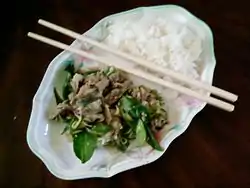

| Name | Description |
|---|---|
| Kuy Teav Kat (meaning cut flat rice noodle) | A dish similar to Chinese cheong fun. A rice mixture is steamed where minced pork is added and rolled up then cut into smaller pieces. It is served with assorted vegetables, cut spring rolls, nuts, fish sauce, and pork ham. It is a speciality in the 'Phnom Penh and Ta Khmao areas. |
| Naem Chao (meaning raw rice paper) (Khmer: ណែម) | A salad roll where assorted vegetables and meats are added and wrapped like spring roll in edible rice paper. Its origin is Vietnam. |
| Chai Yor or Naem Chien (meaning fried spring roll, the name depends on the wrapper used) | A Khmer fried-spring roll that has origins from Cantonese Influences (called Ceon Gyun). The recipe varies from province to province, household to household. |
| Num Porpear | a dessert in which the wrapper originates from Chinese Popiah. This spring roll wrapper also exists in Thailand, Philippines, Malaysia, Singapore, and Indonesia. Porpear often serves as a wrapper for dessert for assorted meats, where many various dishes exist. |
| Nhoam (meaning "mixed raw vegetables or Asian salad")(ញាំ) | Is the general term for a variety of salad dishes that often feature cellophane noodles (mee sua), and boiled chicken and a variety of greens and flowers. |
| Ban hawy (បាញ់ហយ) | Threaded noodle (also called Mee Sua, meaning "sewed rice noodles") that are served in a bowl with assorted vegetables, stir-fried ground pork in soy sauce, oyster sauce, and fish sauce, and topped off with fish sauce and sweet coconut milk. Other variations include pork ham and grilled meat. This noodle is also common to offer to dead ancestors during holidays. Variations of this dish exist all over Southeast Asia. |
| Amok trey (អាម៉ុកត្រី) | is probably Cambodia's most well-known dish amongst visitors; there are similar dishes found in neighboring countries. Freshwater fish fillet (commonly snakehead fish, or Mekong catfish) is covered with an aromatic kroeung (pounded shallots, lemongrass, garlic, kaffir lime), roasted crushed peanuts, coconut milk, and egg and then wrapped in banana leaves and steamed until it achieves a mousse-like texture. Unlike the Thai, Lao and Malaysian versions of the same dish, it is not intended to be spicy but rather fragrant, zesty and flavorful.[14] |
| Pleah sach ko (ភ្លាសាច់គោ) | Lime and prahok-cured beef salad, sometimes also including beef tripe, tossed with thinly sliced purple Asian shallots, finely shaved radish, crushed roasted peanuts and fresh herbs such as mint and basil. Sometimes known as Cambodian beef ceviche, it is very popular at wedding and special occasions. |
| Bok L'hong (បុកល្ហុង) | Khmer green papaya salad, pounded in a mortar and pestle. Related to Laotian Tam mak hoong, the salad may include the herb kantrop, Asian basil, string beans, roasted peanuts, cherry tomatoes, salted preserved small crabs, smoked or dried fish, and chili peppers. Mixed with a savory dressing of lime juice, fish sauce.[15] |
| Mam L'hong | A Khmer green papaya salad that is similar to Bok L'hong with the exception that it features the use of Mam usually Kapi. |
Num (Pastries)
| Name | Description |
|---|---|
| Num Pang (meaning Bread) | A Cambodian take on the Vietnamese Bánh Mì. A similar version is also eaten in Laos and called Khao jee pâté. These are sandwiches feature assorted meats, raw vegetables, and pickled vegetables as well as pate (called "Pat tae" in Khmer), butter, and mayo. |
| Num Pang Ang Sach Ang (meaning grill bread with grill meat) | Is a finger food in which bread are cut into short pieces, brushed with butter and grilled slightly. They are served with satay meat skewers and pickled vegetables. |
| Num Pang Ang Prai M'tes (meaning grilled salty spicy bread) | Is another variation of bread consumption where the whole bread is seasoned with butter, hot sauce, and salt and grilled continuously. The dish may be served by cutting the bread into square bite-size pieces and served with chicken floss, pork ham, mayo, hot sauce, and sauté grilled spring onions. This is also a very popular street in Vietnam where it is called "Bánh mì Khơme (Khmer bread)" or "Bánh mì nướng muối ới" (grilled salty spicy bread). |
| Num Pav | From Chinese Baozi or Ham Bao. It was introduced via Chinese immigrants and is a popular breakfast food where green and red Bao are also seen, created from pandan and dragon fruit skins. |
| Num Bong-Kaong | Khmer shrimp cakes that are deep-fried in a ladle and eaten with various rice and noodle dishes. |
| Num pang chen (literally Chinese bread) | Spring onion bread often referred as Chinese pizza. It combines Chinese and French style foods. It is flat and baked and fried simultaneously rather than simply being fried like its Chinese counterpart.[16] |
| Num Banh Chao (meaning sizzling rice snack) (បាញ់ឆែវ) | A Vietnamese crepe made of coconut milk, rice flour and turmeric. Additionally, ground pork and bean sprouts are added in the middle to add flavor and contrast in texture, eaten with assorted vegetables and fish sauce. |
| Kralan (ក្រឡាន) | A cake (nom) made from a mixture of rice with beans or peas, grated coconut and coconut milk, palm sugar and sometimes sesame, all steamed in a pole of bamboo that gets slowly roasted over charcoal. This dessert has its origins from Laos and Thailand where the dessert is called "Khao Lam" (meaning grilled rice). |
| Num Yip | A yellow star-like dessert made of egg yolk, flour, and sugar. It comes from Portuguese influenced Thai cuisine. |
| Sankya Lapov (សង់ខ្យាល្ពៅ) | A dessert made of pumpkin and coconut flan. It has its origins from Thailand when a Portuguese chef introduced the technique of custard to the Thai king, coining the term "Sankya". This is often added into Cambodian pudding desserts called Cha Houy teuk. |
| Num Banh Duc | A pandan dessert made with rice flour and tapioca starch. |
| Num Plae Ai (meaning Ai fruit cake) | Is a tapioca dessert with a palm sugar filling and topped with coconut shavings. It is a traditional dessert featured in weddings alongside husband and wife cake, and pandan desserts. It can be made with different colors adding a beautiful assortment of colors. It is also called "husband killing cake" because of how easy it is to choke on when consumed. |
| Num Poh Peay | Is a glutinous rice flour dessert that is often called "cassava silkworms". The rice mixture is molded into a worm like shape and boiled, then topped off with coconut shavings, mung beans, and roasted sesame seed. It is eaten with sweet coconut milk. |
| Num Kaov/A'Kaov | Is a steamed cupcake made from rice flour. A Cambodian combines the use of sugar palm (Thnaot) create a white (coconut), yellow (sugar palm) and pandan (green) variation. This is a popular dessert street snack as well as served during traditional weddings. |
| Num Chak Chan | A pandan and coconut milk 4 layered cake that is steamed. It is a common Southeast dessert and also featured within the dessert banquet in Khmer weddings. |
| Num Krok | Is a Khmer coconut-based street food snack. Coconut milk is combined with rice flours with scallions added and cooked on a cast iron griddle with half-spherical moulds. |
| Num Ka'Chai (meaning Chive Cake) | Is a Khmer street food snack of Chinese origin (Teochew "Gu Chai Kue" meaning Chive Cake). It is a rice dumpling combine with chives and fried on a hot surface resembling a think scallion pancake. In Cambodia, the cake is eaten in combination with other dishes to add texture or eaten with sweet fish sauce. |
| Num Pia | A Chinese-Khmer cake that is popular to consume and give during the holidays. It is a specialty in the Siem Reap, Kampot, Phnom Penh, and Ta Khmau areas, and unique given the special red stamp on the top of the cake. |
| Num Kroch (meaning orange cake) | Is a sesame ball of Chinese origin that is fried with a mung bean filling. It is called "orange cake" because of the shape and color after deep frying. |
| Num Kong (meaning bracelet cake) | Is an Asian donut with origins from China that is deep-fried and brushed pork lard and roasted sesame flakes. It is a legacy of Cambodia heavily made before the 1975 genocide and after and becoming a common occupation for Cambodian migrants abroad to open donut shops. |
| Num Pong (meaning egg cake) | Is an Asian donut with origins from China, where the dough is deep-fried and flaked with milk. It is a dessert often sold in Asian stores of any kind abroad. |
| Chak Kwai (Chinese "chopstick" donut) | Is a pastry imported by Hokkien immigrants. It is eaten with Cambodian Kuy Teav and Babor and also eaten with condensed milk. |
| Num Poum (Khmer Coconut Waffle) | A legacy of French Indochina that features a waffle made from rice flour and coconut milk and shavings. |
| Saku Dom (Pandan Tapoica pearls) | A sweet pearl sago/tapioca pearl that is flavor with pandan leaves and pinches of salt. |
| Saku (Tapioca Dessert) | A type of steamed dessert made from Chestnut flour, coconut milk, and cooked mung bean. |
Bai Damnaeb (Sticky Rice Dishes) and Kiev (Dumplings)
| Name | Description |
|---|---|
| Num Sakoo (Meaning Tapioca Cake) | a tapioca ball stuff with a meat dish that is similar to the Thai Khanom Sakoo and Laos Khao Nom Sakoo. Minced meat is seasoned and cooked then wrapped in a tapioca mixture and steamed. The dish is often served with vegetables and sweet sauce. A variation in Vietnam also exists called "Bánh ít trần", as well as Malaysia and Indonesia. |
| Ansom chek (meaning Banana Rice dumpling) (អន្សមចេក) | Is cylindrical rice cake wrapped in banana leaves and filled with bananas (sweet). A similar dish includes Thai Khao tom. |
| Num ansom chrook (អន្សមជ្រូក) | Is a savory variation of a cylindrical rice cake filled with pork and mung bean. It is served during ancestor worship ceremonies and is often cut and deep-fried and served with fish sauce and pickled vegetables. |
| Num Chang | A glutinous rice dumpling made by steaming sweet rice in banana leaves. It is similar to Khmer Ansom except it is built in a triangular shape and has origins from Chinese-style Zongzi, therefore it may feature aged-garlic bulbs, beans, and pork. |
| Num Kom | A glutinous rice dumpling made by steaming rice flour in banana leaves. The shape is cylindrical and the fillings include grounded pork flavored with oyster, fish, and soy sauce. |
| Num Bot | A glutinous rice dumpling made by steaming rice flour in banana leaves. The shape and texture of the rice are similar to Num Kom with the exception that the filling is only mung bean or palm sugar. |
| Num Kmei | A glutinous rice dumpling made by steaming rice flour in banana leaves. The shape is cylindrical and the fillings include coconut shreds and palm sugar. It is popular to make during Pchum Ben. |
| Num Sai Soy | Is a traditional rice dumpling that is made of glutinous rice flour, palm sugar, and pandan juice wrapped and steamed in banana leaves. |
| Siev Mai | Is a Khmer rendition of a Chinese pork dumpling. In Khmer, it not only refers to the dumpling but refers to a style of meatball created by the southern Chinese immigrants in Phnom Penh. |
| Bai Damnaeb Turen (Durian Sticky Rice) | A sticky rice dessert topped with sweet coconut milk and slices of durian fruit. Another variation includes other fruit such as mango (Bai Damnaeb Svay)(បាយដំនើបស្វាយ). |
| Num Treap | Is a sticky rice dessert that is slightly hardened and topped off with roast sesame seed. |
| Bai Ben | A sticky rice dessert that is molded into a ball and topped with sesame seeds. It is very popular during Pchum Ben. |
Cha Houy (Jelly) and Babor P'aem (Pudding)
Cambodian cuisine features a variety of desserts similar to its Southeast Asian neighbors. Its assortment of puddings is called Cha Houy Tuek ("jelly") or Babor P'aem ("sweet porridge") depending on the ingredients of the dish. Agar-Agar jelly desserts are collectively called "Sarai".
| Name | Description |
|---|---|
| Nom Lort | A green or white dessert made from rice flour in a liquid of coconut, milk, water and sugar.[17] A similar dish is Indonesian Cendol. |
| Banh Cheneuk | A rice dumpling dessert served in a ginger sauce similar to Chinese Tong Sui. The rice dumplings are steamed with a mung bean filling and placed in a ginger sauce which is often eaten when sick because of its feng shui properties in food. |
| Thav Ker | The Khmer term for Chinese grass jelly, that is often eaten with soybean milk in a bowl during a hot day because of its cooling properties. |
| Sarai K'tiss | A layered agar jelly dessert featuring pandan and coconut layer jelly. |
| Babor Skor Tau Suan (Mung Bean pudding) | A dessert of Chinese origin that is very popular across other Southeast Asian countries in the Chinese Diaspora.[18][19] It is made of split mung bean sugar, flour and coconut milk. Sino-Khmers prefer this bean pudding with crispy, hot, cut up fried bread Chak Kvay. The word "Tuan Suan" is derived from the Chinese traditional words, " Dòu Shuǎng(豆爽). Dòu means beans and Shuǎng means bright or clear.[20] |
| Tur Tim Krop (Red Lotus Seed jelly) | Tur Tim Grob, a coconut milk-based dessert that is very popular when the weather is hot. The small reddish/pinkish jewels are water chestnut covered with tapioca flour, served with sweetened coconut milk and shaved ice. Shredded jackfruit and jellied coconut flesh can be added to this dessert to make it extra special. Jellied coconut flesh occurs when the coconut lacks an enzyme that turns its flesh into a normal coconut flesh. The flesh continues to develop in the jelly state. Tur Tim, in Khmer, translated literally is either "ruby" or "pomegranate". |
| Bang'Aem Sandaek Khiev (Green Bean Dessert) | This green bean dessert is one of the most popular desserts in Cambodia. People usually have dessert after lunch or after they are off from work in the evening. Dessert stalls are common in Phnom Penh and also mobile stalls that sell many kinds of popular Khmer desserts. |
| Chek K'tiss (Tapioca Banana Pudding) | Ancient banana trees are everywhere, they are one of the most useful and sacred plants that have been in Cambodia for thousands of years. Banana plants are used in many ways, which includes using the young banana blossom for cooking, and the banana leaves for wrapping rice cakes and many other foods. Chopped banana stalks are used as pig feed. Young green bananas can be eaten raw or cooked. Ripened bananas were used for religious food offerings, eaten raw, or turned into delicious desserts. There are many varieties of banana available at the market, but the most preferred type of banana that Khmer Buddhists use for food offering is ladyfinger (miniature) bananas. |
| Babor Skor Mien (Longan Pudding) | A fresh fruit pudding featuring sweet coconut milk flavored with palm sugar and thickened with tapioca starch and topped with Longan. |
| Babor Skor Bot (Sweet Corn Pudding) | A corn-based pudding featuring sweet rice and coconut milk. |
| Babor Skor Krop Phka Chhuk Mien (Lotus Seed and Longan Pudding) | A watery sugar-based dessert that can be served cold or warm. It features longan and lotus seeds and can also be served as a drink. |
Beverages
| Name | Description |
|---|---|
| Te Khiev (Green tea) | A local tea beverage of Cambodia that is commonly served in restaurants either iced or hot. |
| Bia Angkor | A locally made lager beer of Cambodia under the motto "My Country My Beer". |
| Kafe | A popular beverage that is often served Iced or hot, a legacy of the French. It may be served black and strong, or milked with condensed milk to add a sweeter taste. It is generally thicker and sweeter than its Vietnamese counterpart.
|
| Teuk Ampau | Sugar cane juice extracted from squeezing sugar cane plant (sometimes with kumquats to add a hint of citrus flavour), served with ice. |
| Teuk kolok (ទឹក កលក់) (Smoothies) | An important part of an evening's consumption: juice stalls, recognizable by their fruit displays and blenders, set up in towns all over the country from the late afternoon. You can order a mixture of fruits to be juiced or just one or two; coconut milk, sugar syrup, condensed milk and shaved ice are also added, as is a raw egg (unless you specify otherwise – ot yoh pong mowan). |
| Teuk San Daek | Is sold in the morning by street vendors; the green version is sweetened and thicker than the unsweetened white. A soybean drink served either hot or cold, sweetened or unsweetened. |
| Sra Sar (Rice wine/White wine) | A distilled liquor made of rice and popular to consume during festivals. Sra Sol can also be used as a base for traditional Khmer medicinal remedies, which many claim can cure everything from muscle aches, fatigue and stomach disorders to menstrual cramps and labour pains. |
| Teuk Touy (Pandan Juice) | A juice that is made from the extract of Pandan leaves that are usually served in Cambodian Hang Bai (Food Stalls). |
| Te Kroch Chhma | Lemon iced tea. |
| Golden Muscle Wine | A liquor made from deer antlers and Chinese herbs. |
| Teuk Kroch (Lemonade/Soda/Sweet Beverage) | Can be a general term to refer to a sweet drink or specifically sweet and sour limeade. |
| Sra Poas (Snake Wine) | A liquor using snake as a base that is often used for medicinal purposes. |
| Teuk Thnaot (Sugar Palm Juice) | A fermented drink made from sugar palm that is often popularized to be a laxative when consumed. |
| Sra Thnaot Chu (Sugar Palm Wine) | Palm Wine has an important following in Cambodia. It is the traditional drink as true as palm trees dotting the Cambodian landscape are the national trees of the country. Toeuk thnaot is sold around the villages of Cambodia in wooden cylinders attached to the back of bicycles. |
References
- Dunston, Lara (26 June 2020). "Mahob Khmer Chef Sothea Seng on Cambodia's Culinary Heritage". Grantourismo Travels. Retrieved 7 January 2021.
there is a distinction between Khmer food and Cambodian food. Khmer food refers to the food cooked by Cambodia’s predominantly Khmer population, while Cambodian food takes in everything: Khmer food, as well as Chinese-Cambodian, Chinese, and the specialties of Cambodia’s Cham Muslims, such as Saraman curry, a cousin to Thailand’s Massaman curry.
- Thaitawat, Nusara (2000). The Cuisine of Cambodia. Thailand: Nusara & Friends Co. Ltd. p. 24. ISBN 9748778851.
- "As Champagne is to France, Kampot pepper is to Cambodia". The Christian Science Monitor. 23 June 2010. ISSN 0882-7729. Retrieved 25 October 2019.
- Recipes 4 Us Cooking by Country: Cambodia Archived 15 July 2007 at the Wayback Machine Accessed 21 July 2007.
- Vannak, Chea (26 June 2018). "Kampong Speu Palm Sugar earns PGI status in Europe". Khmer Times. Retrieved 25 October 2019.
- Star Chefs Five main Cambodian ingredients Accessed 21 July 2007.
- Chan, Sok (25 June 2018). "Koh Trong pomelo gets GI recognition". Khmer Times. Retrieved 25 October 2019.
- The Worldwide Gourmet Saveurs du Cambodge All you want to know about Cambodian Cuisine Accessed 21 July 2007.
- Lisa Jorgenson, Bonny Wolf Cambodian sweet-and-sour soup Accessed 24 July 2007
- Leisure Cambodia Khmer Sour Soup Archived 2 July 2007 at the Wayback Machine Accessed 23 July 2007
- Chicken Curry Curry Mouan Archived 15 June 2007 at the Wayback Machine Accessed 26 July 2007
- Dudley Brown More than a meal in store Accessed 25 July 2007
- Phil Lees Phnomenom Loc Lac Accessed 22 July 2007
- Mass Recipes Amok Trey Fish Mousselline Archived 29 September 2007 at the Wayback Machine Accessed 22 July 2007
- Tamarind Trees Bok Lhong Archived 24 July 2011 at the Wayback Machine Accessed 10 July 2008
- "Spring Onion Bread: Khmer focaccia | Phnomenon: food in Cambodia". Phnomenon. 24 October 2006. Retrieved 15 June 2012.
- Nom Lote Khmer recipe Accessed 26 January 2013.
- Tua Suan (Split Green Bean Soup) Accessed 29 June 2020.
- Mung Bean Sweet Soup Tau Suan (Split Green Bean Soup) Accessed 29 June 2020.
- Definition for Duo shuang Accessed 29 June 2020.
Further reading
- de Monteiro, Longteine; Neustadt, Katherine (1 November 1998), The Elephant Walk Cookbook: The Exciting World of Cambodian Cuisine from the Nationally Acclaimed Restaurant, Houghton Mifflin Harcourt, ISBN 978-0-395-89253-4. *The Elephant Walk Cookbook is the best-known English-language reference on Cambodian cuisine, and has been an important cultural record, as many of the more elaborate recipes died out in Cambodia following the communist takeover, and have been revived based on The Elephant Walk Cookbook.
External links
| Wikimedia Commons has media related to Cuisine of Cambodia. |

.jpg.webp)
.jpg.webp)